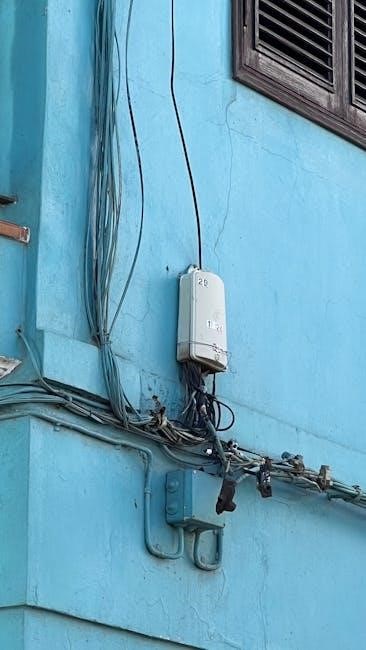The Andersen 400 Series window installation guide provides detailed instructions for various window types, including gliding, tilt-wash, and casement models․ Proper installation ensures energy efficiency, durability, and optimal performance․
1․1 Overview of Andersen 400 Series Windows
The Andersen 400 Series offers versatile window solutions, including gliding, tilt-wash, and casement models․ Known for durability and energy efficiency, these windows feature advanced designs and materials․ The triple-pane glass option enhances thermal performance, making them ideal for various climates․ Designed for both new construction and replacement projects, the 400 Series provides a balance of style, functionality, and long-term value․ Their construction ensures minimal maintenance while delivering superior weather resistance and energy performance․
1․2 Importance of Proper Installation
Proper installation of Andersen 400 Series windows is crucial for ensuring energy efficiency, durability, and optimal performance․ Incorrect installation can lead to air leaks, water damage, and reduced energy efficiency․ Following manufacturer guidelines guarantees safety, warranty validity, and long-term functionality․ Improper techniques may void warranties or cause structural issues․ Correct installation ensures windows operate smoothly, maintain weather tightness, and provide the expected energy savings․ It also prevents potential hazards like water intrusion and drafts, ensuring a secure and comfortable living environment․

Pre-Installation Preparation
Identify all components, tools, and materials before starting․ Verify active and passive sash identification for proper window operation․ Ensure a clean workspace for efficient installation․
2․1 Component Identification
Begin by identifying all components included in the Andersen 400 Series window package․ This includes the window unit, instruction guide, and any additional hardware․ Familiarize yourself with the active and passive sashes, which are crucial for proper operation․ Ensure all parts are accounted for to avoid delays․ Proper component identification ensures a smooth installation process and helps prevent potential issues down the line․ Always cross-reference with the provided manual for accuracy․
2․2 Tools and Materials Required
Ensure you have the necessary tools and materials before starting the installation․ Essential tools include a measuring tape, level, screwdrivers, utility knife, and shimming material․ Safety gear like gloves and safety glasses is also recommended․ Materials needed include weatherproof sealants, flashing tape, and insulation․ Refer to the instruction guide for a detailed list of required items․ Having everything prepared beforehand ensures a smooth and efficient installation process for your Andersen 400 Series windows․
2․3 Active and Passive Window Sash Identification
Identifying the active and passive sashes is crucial for proper installation․ The active sash is the movable part, typically featuring handles or mechanisms for operation․ The passive sash remains stationary, often lacking these features․ Refer to the instruction guide for clear diagrams and labels that distinguish between the two․ Proper identification ensures correct alignment and functionality during installation, preventing potential operational issues․ Always double-check the components against the guide to confirm which sash is active and which is passive before proceeding․

Safety Precautions
Always wear protective gear, including gloves and safety glasses, to prevent injuries․ Ensure structural stability before removing old windows to avoid accidents and property damage․
3․1 Essential Safety Equipment
Ensure safety by wearing gloves, safety glasses, and a dust mask during installation․ Use a ladder stabilizer and secure tools to prevent falls and injuries․ Properly support window units to avoid structural strain and potential damage․ Always follow Andersen’s guidelines for handling glass and window frames to maintain safety standards throughout the process and protect against breakage risks․
3․2 Potential Hazards and Mitigation
Potential hazards during installation include injuries from heavy window units, falling tools, and glass breakage․ Mitigate risks by ensuring proper lifting techniques, securing tools, and clearing the work area․ Weather conditions like strong winds can destabilize ladders or materials, so monitor conditions and use stabilizers․ Always follow Andersen’s safety guidelines to minimize accidents and ensure a secure installation process for both the installer and the property․

Installation Process for Andersen 400 Series Gliding Windows
Install by preparing the rough opening, positioning the active and passive sashes, and securing the window unit․ Follow Andersen’s guide for precise alignment and stability․
4․1 Preparing the Rough Opening
Preparing the rough opening is crucial for a proper installation․ Ensure the opening matches the window dimensions and is free from debris․ Check that the header is securely in place and the sides are plumb․ Verify the sill is level and clear of obstructions․ Refer to Andersen’s guide for specific requirements to ensure a precise fit․ Proper preparation ensures stability and aligns with the window’s design for optimal performance and energy efficiency․
4․2 Positioning the Active and Passive Sashes
Position the active sash into the opening, ensuring it aligns with the frame․ Secure it temporarily using shims and fasteners․ Next, place the passive sash, ensuring proper alignment with the active sash․ Check that both sashes move smoothly and fit snugly within the frame․ Follow Andersen’s guide to ensure correct positioning for optimal functionality and energy efficiency․ Proper alignment prevents air leaks and ensures smooth operation of the window․
4․3 Securing the Window Unit
Once the sashes are properly positioned, secure the window unit by fastening it to the framed opening․ Use shims to maintain proper alignment and ensure the unit is level․ Tighten all fasteners according to Andersen’s specifications․ Verify that the sashes operate smoothly and the unit is tightly sealed․ Apply flashing tape around the perimeter to ensure water tightness and prevent air leaks․ Follow Andersen’s guidelines for final securing to guarantee a stable and efficient installation;

Installation Process for Andersen 400 Series Tilt-Wash Double-Hung Windows
Install the tilt-wash double-hung window by preparing the rough opening, tilting the sashes for easy access, and securing the unit with proper alignment and fastening techniques․
5․1 Preparing the Rough Opening
Ensure the rough opening is level, plumb, and square․ Check for any debris or obstructions․ Verify the opening dimensions match the window specifications․ Apply a weather-resistant barrier to the exterior sheathing․ Install shims around the perimeter to level the window unit․ Ensure the sill is properly sloped for water drainage․ Complete any necessary flashing before placing the window to maintain structural integrity and prevent water infiltration․
5․2 Tilting and Securing the Sashes
Tilt the sashes inward by releasing the tilt latches located at the top․ Carefully lift and remove the sashes for easier access to the window frame․ Once the sashes are removed, position the tilt-wash unit into the prepared rough opening․ Secure the unit using screws provided, ensuring proper alignment with the surrounding wall․ After installation, reinstall the sashes by aligning the hinges and engaging the tilt latches․ Test the sashes to ensure smooth operation and proper sealing․
5․3 Ensuring Proper Alignment
Ensure the window unit is properly aligned with the surrounding wall and framing․ Use shims to adjust the frame for a level and plumb fit․ Verify that the sashes align correctly with the frame and operate smoothly․ Double-check that all fasteners are securely tightened to maintain stability․ Proper alignment prevents operational issues and ensures energy efficiency․ Misalignment can lead to air leaks or difficulty in opening and closing the window, so careful adjustment is essential during installation․

Installation Process for Andersen 400 Series Casement/Awning Windows
Follow the installation guide for Andersen 400 Series Casement/Awning Windows with Stormwatch Protection․ Prepare the rough opening, ensuring proper placement and alignment․ Secure the window unit firmly, adhering to manufacturer instructions for weather protection and stability․ Proper installation ensures smooth operation and durability․ Consult guidelines for specific conditions or materials․ Ensure all fasteners are tightened securely to maintain structural integrity and prevent air leaks․
6․1 Preparing the Rough Opening
Ensure the rough opening matches the Andersen 400 Series Casement/Awning window dimensions․ Verify the opening is square and level, using shims if necessary․ Clean the area of debris to ensure proper fit and alignment․ Check for any obstructions or uneven surfaces that could affect installation․ Proper preparation of the rough opening is critical for weather-tight sealing and smooth window operation․ Follow the manufacturer’s guidelines for specific requirements, ensuring compliance with local building codes and standards․
6․2 Proper Placement and Alignment
Position the Andersen 400 Series Casement/Awning window unit in the prepared rough opening, ensuring it is centered and aligned with the surrounding structure․ Use shims to adjust the window frame for proper plumb and level alignment․ Verify the unit is square by measuring diagonals to ensure accuracy․ Secure the window temporarily to maintain placement while finalizing the installation․ Proper alignment ensures smooth operation of casement or awning sashes and prevents air leaks or operational issues․ Follow manufacturer guidelines for precise placement and alignment techniques․
6․3 Securing the Window Unit
Once properly aligned, secure the Andersen 400 Series Casement/Awning window unit using the recommended fasteners․ Ensure shims are in place to maintain alignment and prevent shifting․ Apply weatherproof sealant around the perimeter to create a tight seal․ Tighten all fasteners in a star pattern to avoid warping the frame․ Verify the window is level and plumb before finalizing․ Proper securing ensures long-term stability, prevents air leaks, and maintains the window’s structural integrity․ Follow Andersen’s guidelines for fastener placement and torque specifications․

Flashing and Water Management
Proper flashing and water management are crucial for Andersen 400 Series windows․ Apply durable flashing tape around the window perimeter to direct water away, preventing leaks and structural damage․
7․1 Applying Flashing Tape
Applying flashing tape to Andersen 400 Series windows is essential to ensure proper water management․ Begin by cleaning the surface around the window frame to ensure a strong bond․ Cut the flashing tape to the required length and press it firmly along the edges, starting from the bottom and moving upwards․ Ensure the tape is sealed tightly around corners and edges to prevent water infiltration․ Follow the manufacturer’s instructions for the best results and to maintain the window’s warranty․
7․2 Ensuring Proper Water Drainage
7․3 Sealing Gaps and Joints
Sealing gaps and joints around Andersen 400 Series windows is crucial for energy efficiency and preventing air leaks․ Use weatherproof sealants or spray foam to fill any gaps between the window frame and the surrounding wall․ Ensure all joints are tightly sealed, especially at the corners and edges․ Proper sealing helps maintain thermal performance and prevents moisture damage․ Follow the manufacturer’s recommendations for the best materials and techniques to achieve a secure, airtight seal around the window unit․
Sealing gaps and joints around Andersen 400 Series windows is essential for maintaining energy efficiency and preventing water intrusion․ Use weatherproof sealants or spray foam to fill gaps between the window frame and surrounding walls․ Pay special attention to corners and edges, ensuring all joints are tightly sealed․ This step helps prevent air leaks, reduces moisture damage, and enhances overall thermal performance․ Always follow Andersen’s recommendations for approved materials and techniques to achieve a durable, watertight seal․

Energy Efficiency Considerations
Andersen 400 Series windows are designed for superior energy efficiency, featuring triple-pane glass and advanced sealing technologies․ Proper installation ensures optimal thermal performance and reduced energy consumption year-round․
8․1 Features of Andersen 400 Series Windows
Andersen 400 Series windows are known for their advanced energy-efficient features, including triple-pane glass, Low-E coatings, and insulated frames․ These features minimize heat transfer and reduce noise․ The series offers durable construction with weather-tight seals, ensuring long-lasting performance․ Optional smart glass technology allows for adjustable tint, enhancing light control and energy savings․ These windows are designed to meet high energy standards, making them a sustainable choice for modern homes․
8․2 Impact of Proper Installation on Energy Efficiency
Proper installation of Andersen 400 Series windows is crucial for maximizing energy efficiency․ Correct sealing, alignment, and insulation ensure minimal air leakage and heat transfer․ Improper installation can compromise the window’s energy-saving features, leading to increased energy consumption․ By following Andersen’s installation guidelines, homeowners can maintain the windows’ thermal performance, reduce drafts, and lower heating and cooling costs․ Proper installation also ensures the product meets energy standards and maintains its warranty validity․
8․3 Benefits of Triple-Pane Glass
Triple-pane glass in Andersen 400 Series windows offers exceptional energy efficiency, noise reduction, and comfort․ It minimizes heat transfer, reducing energy consumption and lowering utility bills․ The multiple glass layers act as a sound barrier, creating a quieter indoor environment․ Triple-pane glass also reduces condensation, improving visibility and maintenance․ It enhances environmental sustainability by decreasing heating and cooling demands, making it a premium choice for energy-conscious homeowners seeking long-term benefits and improved home performance․

Final Inspection and Testing
After installation, inspect the window for proper fit, alignment, and operation․ Test all features, including opening, closing, and locking mechanisms․ Ensure sealing is airtight and secure․
9․1 Checking the Fit and Alignment
Ensure the window fits snugly in the rough opening, with even spacing on all sides․ Verify that the unit is square and plumb using a level․ Check for proper shimming and alignment of the sashes․ Inspect the window frame for any gaps or misalignment with the surrounding wall․ Ensure the window operates smoothly without binding or resistance․ Proper fit and alignment are critical for optimal performance, energy efficiency, and long-term durability of the Andersen 400 Series windows․
9․2 Testing Window Operation
After installation, test each window’s operation to ensure smooth functionality․ Open and close sashes, checking for ease of movement and proper alignment․ Verify that all locking mechanisms engage securely and release smoothly․ For tilt-wash models, test the tilt function to ensure it operates correctly․ Gliding windows should slide effortlessly without binding․ Casement and awning windows should open and close fully, with hinges and handles functioning as intended․ Proper operation ensures safety, energy efficiency, and long-term performance of the Andersen 400 Series windows․
9․3 Ensuring Proper Sealing
After installation, inspect all seals and weatherstripping for proper alignment and compression․ Test for air leaks by holding a candle or incense near the window edges․ Ensure all gaps are sealed to prevent air infiltration and moisture entry․ Proper sealing is critical for energy efficiency, noise reduction, and protection against weather elements․ Verify that all sashes close tightly against the frame, ensuring a weather-tight seal․ Address any gaps or leaks promptly to maintain the window’s performance and durability․

Troubleshooting Common Issues
Identify and address air leaks, misalignment, or operational difficulties promptly․ Check sash alignment, weatherstripping, and frame seals․ Consult Andersen’s installation guide for specific solutions and adjustments․
10․1 Addressing Air Leaks
Air leaks can compromise energy efficiency and comfort․ Inspect gaps around the window frame and sashes․ Check weatherstripping for wear or damage․ Reapply caulk or sealant to gaps, ensuring proper adhesion․ Verify that all sashes are aligned and closed securely․ If leaks persist, consult Andersen’s installation guide for specific sealing recommendations․ Proper sealing is crucial for maintaining the window’s performance and energy efficiency․ Regular inspections and maintenance can prevent air leaks from developing over time․
10․2 Fixing Misalignment Issues
Misalignment can affect proper window function and sealing․ Start by checking the sashes and frame for uneven positioning․ Adjust shims to level the window unit, ensuring all sides are evenly spaced․ For gliding windows, verify that the active sash rolls smoothly within the track․ If misalignment persists, consult Andersen’s installation guide for specific adjustment instructions․ Proper alignment ensures smooth operation and prevents wear on moving parts․ Regular checks can help maintain optimal window performance and longevity․
10․3 Resolving Operational Difficulties
Operational issues, such as difficulty opening or closing, often stem from improper installation or debris buildup․ Inspect the tracks and rollers for obstructions and clean them thoroughly; Lubricate moving parts with silicone-based spray to ensure smooth operation․ For tilt-wash models, check that the sashes are properly tilted and aligned․ Refer to Andersen’s troubleshooting guide for specific solutions, and ensure all components are securely fastened․ Addressing these issues promptly prevents further damage and maintains the window’s functionality and energy efficiency over time․ Regular maintenance can also help prevent operational difficulties․
Maintenance and Care
Regular cleaning of Andersen 400 Series windows ensures clarity and functionality․ Lubricate moving parts annually and inspect for damage or wear to maintain optimal performance and longevity․
11․1 Cleaning the Windows
Regular cleaning is essential to maintain the clarity and functionality of Andersen 400 Series windows․ Use mild detergent and water with a soft cloth or sponge to avoid scratching․ Avoid harsh chemicals or abrasive materials that may damage the glass or frames․ For stubborn stains, a vinegar and water solution can be effective․ Clean the sashes and tracks to ensure smooth operation․ Regular maintenance helps preserve the windows’ appearance and performance over time․
11․2 Lubricating Moving Parts
Lubricating moving parts of Andersen 400 Series windows ensures smooth operation and longevity․ Apply a silicone-based lubricant to hinges, rollers, and locks annually․ Avoid using oil-based products, as they can attract dust and dirt․ Clean the parts before applying lubricant to remove any debris․ Proper lubrication prevents squeaking and stiffness, maintaining the windows’ functionality․ This simple maintenance step helps extend the lifespan of the window components and ensures consistent performance over time․
11․3 Inspecting for Damage
Regularly inspect Andersen 400 Series windows for damage to ensure optimal performance․ Check for cracks, gaps, or water damage on sashes and frames․ Inspect glass for breaks or failed seals, which may cause fogging․ Test all moving parts, like hinges and handles, to ensure proper function․ Address any issues promptly to prevent further damage․ Regular inspections help maintain energy efficiency and longevity, ensuring your windows continue to perform as intended and uphold their warranty standards․
